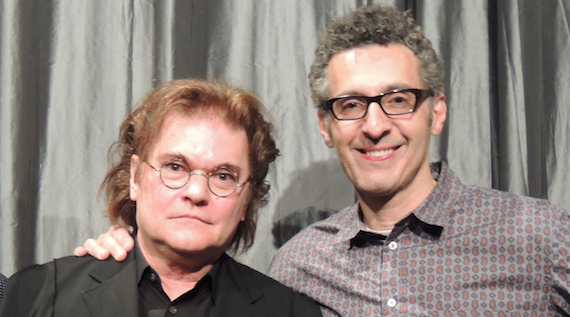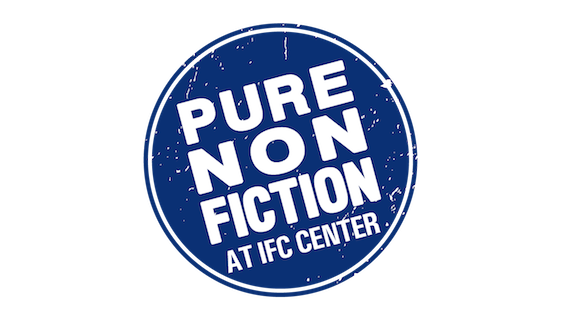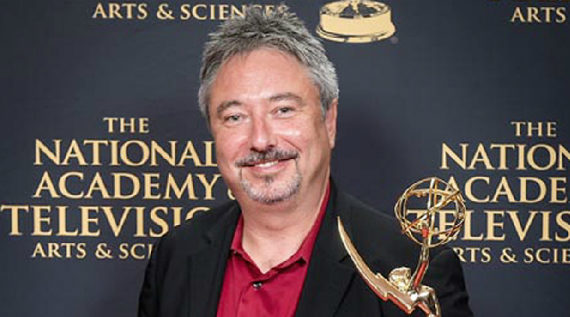
Director Roman Paska with actor John Turturro present Rehearsal for a Sicilian Tragedy
STF’s Winter 2013 season kicked off last Tuesday with a sold-out screening of Rehearsal for a Sicilian Tragedy. Director Roman Paska follows actor John Turturro throughout Western Sicily as they research a future film project about traditional Sicilian puppeteering. In addition to his conversations with professional puppeteers, local historians, and young actresses, Turturro traces his maternal roots in the region, exploring the neighborhood where his grandmother lived before immigrating to the United States. Paska and Turturro’s trip coincides with preparations for the Day of the Dead, an annual celebration that, in the context of the film, provides Turturro with the opportunity to remember his recently-deceased mother and the ways in which he still feels their relationship when he visits Italy. Rehearsal for a Sicilian Tragedy explores the connections between death, tradition, and memory, and the ways in which these themes inform one’s relationship to one’s familial and cultural identities. After the screening, Paska and Turturro joined STF’s Artistic Director Thom Powers for a Q&A.
Stranger Than Fiction: John, I mentioned before in my introduction that you and Roman have known each other for a long time. How did this project come about?
John Turturro: Someone asked me if I was interested in doing a documentary, and I knew I didn’t have that much time to do all the work. I suggested Roman because I knew he had great knowledge of the Sicilian puppet tradition. We had been talking about maybe making a film about a puppeteer. So I suggested Roman, and he met them and got the job, and then he hired me.
STF: Roman, can you describe your own background in puppetry?
Roman Paska: Well, I am also a puppeteer and have been a puppeteer for many, many years. In the course of my own work, I did a lot of traveling and performing in Europe and had actually met [puppeteer] Mimmo Cuticchio many years before we did the film. He was someone who struck me because he’s very much an exemplar of living tradition. There are very few traditions left in Europe and even in the world. And in fact, at one point, I brought a book that Mimmo had published about his family tradition as a present for John. So the idea of putting them together in a film was very fortuitous.
Audience: Can you comment on the layers of the film, particularly the layer of your relationship to Sicily and your mother?
Turturro: Well, I worked in Sicily in 1986. I did a terrible movie called The Sicilian that Michael Cimino directed and spent a lot of time there, and I’ve been there for a lot of other reasons. I guess when you lose your mother and your father, it’s always interesting to go back to places where you feel some sort of connection. When I go to Italy, I usually feel that way, and Sicily is a very specific place. I’ve worked there a couple of times. It’s a very integrated island, an island that’s been invaded by everybody, and it’s a very specific place. It’s different going back now, not being able to come home and bring gifts and things to your family that is living. And there are traditions that I don’t have anymore. So that was something that Roman asked me to do. I had a little trepidation about it, but then again, I felt like that’s something people go through. That’s sort of a universal thing that happens when people come to this country.
Audience: Is there a particular thing that was the highlight of enjoyment of this experience?
Paska: I would say one of the most gratifying things that happened, from my point of view, is that John arrived to do this film directly from shooting Transformers 2. I mean literally, the next day. And they were in Egypt or Jordan…
Turturro: I think I came from Jordan.
Paska: And actually, he was holding us up for a couple of days, because they kept keeping him there, and we were of course waiting and waiting. So when John arrived, we literally jumped right in. And he had never seen the performance of the puppets before. He had really never seen it before. So we were really capturing his genuine enthusiastic response and wonder and so forth to seeing this tradition. And I remember at the end of the first day, John saying to me, “Well, I didn’t realize it was going to be like this!” He was very excited. So, for me, that was the highlight.
Turturro: I think working with Mimmo was a little intimidating at first. He was actually not very nice to me at first. He’s very Sicilian, so he was imprisoned in his own personality. But then he warmed up, little by little, because he really is a master at what he does. But I was a little intimidated by him, especially when he was showing me how to do the puppets. It was kind of a thrill to be in the presence of somebody who has given his life to that.
Audience: Roman, we know about John’s background – Sicilian and from Puglia – but are you also Italian?
Turturro: He’s an Italian citizen. (laughter)
Audience: Because your name throws me.
Paska: Right, no, I’m only Italian by…I’m an Italophile, I guess. My name is Polish, actually, and there’s some Irish in there, and maybe a smidgen of German.
Turturro: But he speaks Italian.
Paska: I do speak Italian. I’ve done a lot of work in Italy, so if I am choosing where to be reborn, I might well choose the Amalfi Coast. (laughter)
Audience: Were all of the girls in the movie part of an acting troupe?
Paska: No. (laughter) But before John arrived, we let it be known that we were casting for a movie in which John would play a Sicilian puppeteer, a puparo. So the fiction on which the film is based, the film within the film, the film that we were setting out to make – and maybe, someday, we might still make – and the girls responded to our surprise, a huge number of girls from all over Sicily. We wanted the puppeteer’s assistant to be a girl, because of the association with the maternal side of John’s family and so forth, and we were revisiting Sicily because of his grandmother and his mother and so forth. So we actually had a kind of pre-audition. The girls were from various different regions. They didn’t know one another, maybe they got to know one another a little bit, and then when we chose a sort of core group that we then filmed. We asked them all to bring clothing that they felt their grandparents might wear. That was to get them into a different mindset. But very few of them had any prior acting experience, with one or two exceptions, who had minor roles in theater or film.
Audience: I was wondering about the tradition of the puppeteers with the Furioso. Did they keep the story true to the original Furioso? Did they play around with it over the years and use it for social commentary?
Paska: No, they don’t. The main source material is Ariosto’s Orlando Furioso. Everyone knows the stories so well that, as you can see even from the audition of the young girls, that the puppeteers would be judged by the merits of the way in which they interpreted the story differently, or in which they might introduce a whole sub-story that wasn’t in the original. Like when Orlando is going through the forest and he takes a detour, and then there could be a whole other little drama that is played out. But the stories used to be performed over the course of a year. People would go every night, and they’d hang out, and the puppeteer would do a different episode. That’s not true anymore. The stories have become much closer now to the body of the original text then they might have been in the past.
STF: John, after this film you directed your own documentary in Italy, Passione, about the music of Naples. (applause) I wonder, having done these two, did they satisfy what you wanted to say about Italy, or could you see going back and drawing more from that?
Turturro: Well, you know, I actually did a play in New York with Roman and Donna based on an Eduardo De Filippo play, and we did it in Naples together. That was really my first experience being in Naples. Which is different, I have a lot of cousins who are half-Neapolitan. Any time I get to go there, it’s very interesting. But both of these experiences were really educational for me, in a big way. One I had a supporting role in, being the person in the movie. The other I was serving all these musicians, something that I really love to do, too. So I would work there really when I have the opportunity to do something interesting, that I could never get a chance to do again. It’s really nourishing, on many different levels.
STF: But not The Sicilian 2.
Turturro: The Sicilian 2? Oh, with Michael Cimino. (laughter) No, but there are lots of wonderful stories that I’d love to explore and do over there.
Audience: In the scene with the sword, when he’s declaiming, it seems like you’re sort of confronted with this history of acting that goes back to almost Homer, you know, talking to rooms full of people eating. And I was just interested to see, coming from kind of the American tradition of realism…
Turturro: Really? I don’t come from an American tradition of realism. Not in my house. (laughter) Anything that Mimmo did wasn’t really that different than watching my father tell the story. I mean, really. It’s just done in a much more skillful way. But the idea of realism – you have to understand, if you come from an Italian tradition, what we think is just a normal encounter for someone else is a gigantic experience for us. So when I see opera, or Greek theater, to me that seems very real. When I watch realism a lot of times, I think that’s very fabricated. Very fabricated. Because I think people have a tremendous diversity of expression, and, you know, in a certain short story form, or two-hour form, sometimes you don’t see that.
Audience: When he’s doing that thing with the sword and it’s so like one person telling the whole story, as opposed to the interaction, it was fascinating to watch him, because he’s so good at it.
Turturro: He’s really great at it. I mean, at the same time, maybe you wouldn’t want to be his son. (laughter) There are plusses and minuses there. (laughter)
Audience: I was hoping you could talk a little bit about the locations, what they were, and how you found them.
Paska: I scouted the whole island for locations, but for practical reasons in the end we decided to limit ourselves to a few. If you know the island of Sicily and drew a line from Palermo down to Agrigento, every place we shot was to the west of that line, and in Palermo and Agrigento. But that was because, despite the fact that Sicily is a relatively small island on the map, it’s hard to get around. And it takes a long time to get from Point A to Point B because of the roads being what they are and so forth. So we limited ourselves to Western Sicily.
Audience: What was the church in the beginning, where he’s talking about death and you see all of the skeletons hanging everywhere?
Paska: You mean with the mummies? It’s in Palermo. There are a couple of other places where the same thing was done, but that’s the one that’s best known and best preserved. It’s called the Catacombs of the Capuchins, Catacombe dei Cappuccini, and the mummies are arranged in a somewhat theatrical way, really, to impress you with the enormity of death and so forth. There are even rooms dedicated to specific professions. Professors in one room, doctors in another. (laughter) But it was part of the tradition to visit the dead on the Day of the Dead, and so in certain cases, people with money would actually pay to have their relative displayed, and they would have their lunch in the Catacombs. One of the mummies that we filmed has glass eyes, because the family actually paid to have glass eyes put in the mummy because he was known as a ladies’ man, and they wanted him to be able to watch the women pass. (laughter). And of course, for myself and for the purposes of the film, the association between the mummies and the puppets is very important.
Related Film






